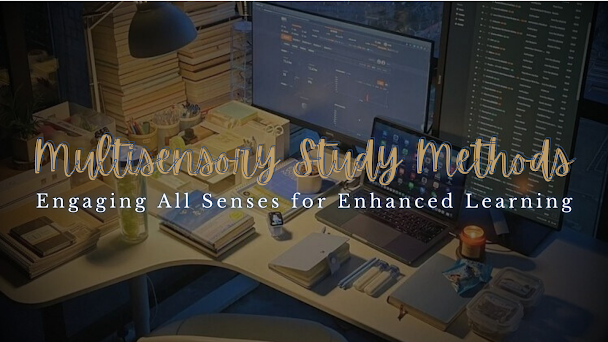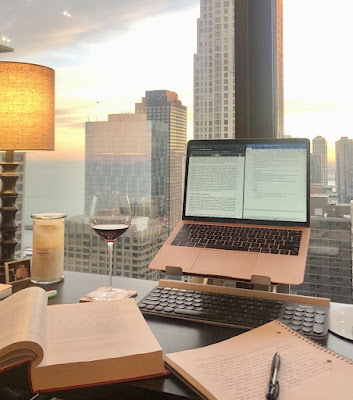Multisensory Study Methods: Engaging All Senses for Enhanced Learning
In the journey of learning and studying, engaging multiple senses can significantly amplify the learning experience. Multisensory study methods integrate visual, auditory, tactile, and even immersive elements to enhance comprehension, retention, and application of knowledge. In this blog post, we will delve into a variety of multisensory techniques that cater to diverse learning styles and provide a comprehensive approach to effective learning.
Understanding Multisensory Learning:
Multisensory learning involves engaging multiple senses simultaneously to enhance the learning process. By combining sensory modalities, learners can create stronger connections to the material, leading to deeper understanding and more effective retention. This approach accommodates different learning preferences and optimizes the learning experience.
Visual Mnemonics: Connecting Images with Information
- The Power of Visual Mnemonics:
Visual mnemonics leverage the visual sense to create associations between images and information. This technique taps into the brain's natural ability to remember images more vividly than abstract concepts, making it a powerful tool for memorization.
- Techniques for Creating Effective Visual Mnemonics:
When creating visual mnemonics, associate key information with memorable images. Use vivid colors, bold shapes, and creative representations to enhance recall. Connect concepts through visual cues and spatial relationships. The more unique and personal the imagery, the stronger the memory association.
- Enhancing Memory Recall through Visual Associations:
Visual mnemonics transform abstract information into memorable visual narratives. By linking complex ideas with relatable images, learners can retrieve information more easily during exams or recall sessions. This technique is particularly effective for lists, sequences, and vocabulary.
Music and Rhythm: Enhancing Focus and Retention
- The Impact of Music and Rhythm on Learning:
Music and rhythm engage the auditory sense and have a profound effect on mood, focus, and memory. Selecting appropriate background music or incorporating rhythmic patterns can enhance the overall learning experience.
- Choosing Appropriate Music for Studying:
Choose instrumental music or ambient sounds that enhance concentration and relaxation. Avoid lyrics that might compete with the content you're studying. Experiment with different genres to discover what works best for your focus and energy levels.
- Incorporating Rhythm and Movement for Improved Engagement:
Incorporate rhythmic patterns while studying to create a sense of rhythm and structure. Use a metronome or rhythmically tap your foot to align with key concepts. Additionally, take movement breaks where you engage in light physical activity in sync with the rhythm to re-energize your brain.
Tactile and Hands-On Learning: Engaging the Sense of Touch
- The Benefits of Tactile and Hands-On Learning:
Tactile learning involves the sense of touch and manipulation of physical objects. It enhances kinesthetic engagement and provides a concrete way to understand abstract concepts.
- Utilizing Manipulatives and Tactile Materials:
Incorporate manipulatives like puzzle pieces, building blocks, or textured materials that correspond to the subject matter. Use these objects to model concepts or create interactive experiences that reinforce learning.
- Creating Interactive Experiences for Enhanced Understanding:
Design hands-on activities that invite learners to physically interact with the content. For example, use building blocks to construct historical landmarks or use modeling clay to create biological structures. The tactile experience cements understanding and makes learning more memorable.
Immersive Technologies: Virtual Reality and Augmented Reality
- Exploring Immersive Technologies for Learning:
Immersive technologies like virtual reality (VR) and augmented reality (AR) transport learners to virtual environments where they can engage with content in a multi-dimensional way.
- Utilizing Virtual Reality for Simulations and Experiments:
VR enables learners to simulate experiments, explore historical settings, or travel to faraway places. These experiences provide a visceral connection to the material, fostering deeper comprehension and a memorable learning journey.
- Enhancing Real-World Interactions with Augmented Reality:
AR overlays digital elements onto the real world, creating interactive and enriching experiences. Augmented reality apps can bring textbook illustrations to life or provide interactive annotations during presentations, adding a new layer of engagement.
Combining Sensory Modalities: Creating a Multisensory Experience
- Integrating Visual, Auditory, and Kinesthetic Elements:
To create a comprehensive multisensory experience, combine visual mnemonics, auditory cues, and tactile engagement. For instance, while studying history, you can visualize historical events using images, listen to relevant audio clips, and physically arrange timelines or maps.
- Designing Multisensory Study Environments:
Create a study environment that accommodates various sensory modalities. Use color-coded notes, engaging background music, and tactile materials. Incorporate aromatherapy with scents like lavender or peppermint to stimulate memory.
- Engaging All Senses for Comprehensive Learning:
Engaging multiple senses simultaneously enhances the overall learning experience. Multisensory learning creates rich connections between concepts and sensory stimuli, resulting in better comprehension, retention, and application of knowledge.
Utilizing Technology for Multisensory Learning
- Interactive Learning Apps and Platforms:
Explore interactive apps and platforms that combine visual, auditory, and tactile elements. Look for tools that offer quizzes with audio explanations, interactive diagrams, and touch-based activities.
- Multimedia Presentations and Videos:
Create or seek out multimedia presentations that incorporate visuals, audio narration, and animations. These presentations cater to different learning styles and provide a dynamic way to engage with the material.
- Immersive Learning Experiences through Virtual Tools:
Utilize virtual tools that offer immersive learning experiences. Virtual labs, 3D models, and interactive simulations engage learners on multiple sensory levels, making complex concepts more accessible and memorable.
Incorporating Multisensory Study Methods Into Your Routine
To make the most of multisensory study methods, consider the following tips:
- Identify your learning preferences: Recognize which sensory modalities resonate with you the most and prioritize activities that engage those senses.
- Be creative: Experiment with different techniques and modalities to discover what works best for your learning style.
- Combine methods strategically: Integrate multisensory techniques into your study routine by combining visual mnemonics, music, tactile engagement, and immersive experiences.
- Be mindful of distractions: While multisensory experiences can enhance learning, be cautious not to overwhelm yourself with sensory stimuli that might hinder focus.
Tips for Effective Multisensory Study Sessions
- Create a multisensory study plan: Plan your study sessions with a variety of multisensory activities that cater to different senses.
- Take breaks: Incorporate short breaks to reset your senses and avoid sensory overload.
- Reflect on your experience: After each multisensory study session, reflect on how each modality contributed to your understanding and retention of the material.
Conclusion:
Multisensory study methods offer a holistic and engaging approach to learning. By integrating visual, auditory, tactile, and immersive elements, learners can create richer connections to the material, enhance comprehension, and retain knowledge more effectively. Through technology, hands-on activities, and creative engagement, multisensory learning provides a diverse toolkit for optimizing the learning experience. By incorporating multisensory study methods into your routine and adapting them to your unique preferences, you can achieve greater academic success and make learning a multisensory journey of discovery.
Links:
- HOW TO STUDY SMART (PART 1)
- HOW TO STUDY SMART (PART 2)
- HOW TO PLAN LONG TERM
- PLANNING TIPS FOR BEGINNERS
- UNLEASHING YOUR INNER MOTIVATION: STRATEGIES FOR DAILY INSPIRATION
- TIME MANAGEMENT FOR PERSONAL LIFE: BALANCING PRIORITIES AND ENHANCING WELL-BEING
- UNLOCKING PRODUCTIVITY: EFFECTIVE TIME MANAGEMENT TECHNIQUES FOR SUCCESS
- THE HOLISTIC APPROACH TO SELF-CARE: NURTURING DIFFERENT ASPECTS OF YOUR LIFE AND EFFECTIVE TECHNIQUES
- ACTIVE RECALL STUDY METHODS: ENHANCING LEARNING AND RETENTION
- DISCOVERING EFFECTIVE STUDY METHODS: UNLOCKING YOUR LEARNING POTENTIAL
- VISUAL STUDY METHODS: ENHANCING LEARNING THROUGH VISUAL TECHNIQUES
- AUDITORY STUDY METHODS: HARNESSING THE POWER OF SOUND FOR EFFECTIVE LEARNING
- KINESTHETIC STUDY METHODS: ENGAGING THE BODY FOR ACTIVE LEARNING
- ACTIVE STUDY METHODS: MAXIMIZING LEARNING THROUGH ENGAGEMENT
- TIME MANAGEMENT AND STUDY ENVIRONMENT: KEYS TO PRODUCTIVE LEARNING
- HOW TO STUDY LIKE PARIS GELLER: MASTERING THE ART OF ACADEMIC EXCELLENCE
- HOW TO STUDY LIKE RORY GILMORE: A COMPREHENSIVE GUIDE TO ACADEMIC SUCCESS






.png)
.png)
Comments
Post a Comment